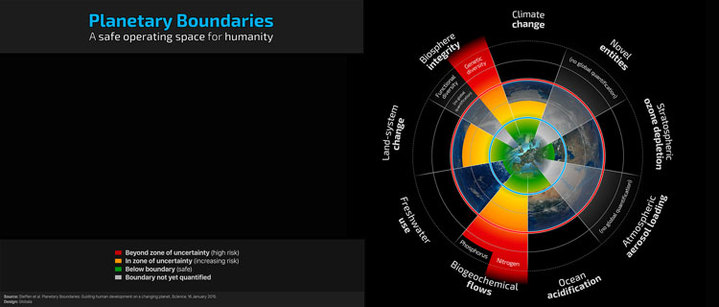 Picture Credit: Stockholm Resilience Centre
Picture Credit: Stockholm Resilience Centre The original Planetary Boundaries framework was published in Nature in in 2009 and an update of the research, Planetary Boundaries 2.0, has just been published in Science. Despite dozens of peer reviewed critiques that have strengthened the evidence in the updated version, none of the boundaries have been dropped nor have any been added, highlighting the robustness of the framework. The boundaries are now more granular though, and allow them to be applied more easily at a regional level.
In summary, it proposes nine key planetary boundaries that we need to remain within to avoid abrupt and potentially irreversible tipping points in the earth system (see below). Climate Change and Biosphere Integrity are the two principal boundaries, whilst the seven others are all still critical with potential knock-on effects on many other boundaries if they are transgressed. They are: Stratospheric Ozone Depletion, Atmospheric Aerosol Loading (soot, diesel particulates, steam etc.), Ocean Acidification, Biochemical Flows of Nitrogen and Phosphorous, Freshwater Use, Land-System Change (deforestation, agricultural use, etc) and Novel Entities (pollution by toxic synthetic substances, release of radioactive materials or nanomaterials etc.). We have already transgressed four of the nine boundaries (see diagram) highlighting the critical importance of accelerating sustainability efforts globally.
The course unsurprisingly focussed on the remarkable resilience of the earth system but spends significant time highlighting the concept of planetary and local scale tipping points. Tipping points are where systems (in this case- Earth Systems) reach critical points where they suddenly and rapidly transform into new systems and stable states; critically it is often very difficult to revert to the original state. Examples of this in nature that we have already witnessed include dead zones in coral reefs or eutrophication of fresh water lakes. It forms the crux of the argument for staying within planetary boundaries.
To me, what is most powerful about the Planetary Boundaries framework is that it approaches the issue from such a neutral point of view – it is not trying to argue right or wrong but merely to indicate where the boundaries of human development lie. It will then be up to all of us to work out how we organise ourselves to remain within these boundaries.
It starts with a simple question: 'what is the optimal state of the earth to support human development and thriving?' The unequivocal evidence is that the Holocene of the last 10,000 years represents this. Until the Holocene we did not have the conditions to develop modern agriculture which ultimately underpins human prosperity today, and it is no surprise that we have seen such phenomenal progress in the last 10,000 years. If we accept this, then surely our goal as humans in the Anthropocene is to do everything we can to stay within this state? Carl Folke, Science Director at the Stockholm Resilience Centre, summarises it perfectly:
As a final thought, and with Paris 2015 looming large, I would propose that the Planetary Boundaries need to feature much more heavily in negotiations and the setting of the Sustainable Development Goals. Rockström highlights that most of the social goals are quantified with clear deadlines whilst the environmental goals are mainly statements of intent without hard targets or dates – the Planetary Boundaries framework wouldn't be a bad place to go for some of these…
by Jesper Ekelund
| | |

 RSS Feed
RSS Feed